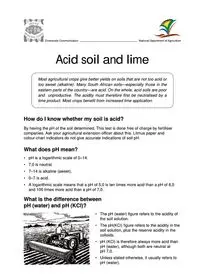
Acid Soil And Lime 2000 PDF
Preview Acid Soil And Lime 2000
Most agricultural crops give better yields on soils that are not too acid or too sweet (alkaline). Many South African soils—especially those in the eastern parts of the country—are acid. On the whole, acid soils are poor and unproductive. The acidity must therefore first be neutralised by a lime product. Most crops benefit from increased lime application. How do I know whether my soil is acid? By having the pH of the soil determined. This test is done free of charge by fertiliser companies. Ask your agricultural extension officer about this. Litmus paper and colour-chart indicators do not give accurate indications of soil pH. What does pH mean? • pH is a logarithmic scale of 0–14. • 7,0 is neutral. • 7–14 is alkaline (sweet). • 0–7 is acid. • A logarithmic scale means that a pH of 5,0 is ten times more acid than a pH of 6,0 and 100 times more acid than a pH of 7,0. What is the difference between pH (water) and pH (KCl)? • The pH (water) figure refers to the acidity of the soil solution. • The pH(KCl) figure refers to the acidity in the soil solution, plus the reserve acidity in the colloids. • pH (KCl) is therefore always more acid than pH (water), although both are neutral at pH 7,0. • Unless stated otherwise, it usually refers to pH (water). Acid soil and lime Directorate Communication National Department of Agriculture What causes soil acidity? • Crops get their nutrients direct from the soil solution or from the colloids in the soil. As soon as basic plant nutrients such as calcium, magnesium and potassium in the colloids are replaced by hydrogen and aluminium, the soil becomes acid. • This replacement or exchange of nutrients is caused by leaching after heavy rain or the uptake of plant nutrients by the crop. • Soil acidity is therefore regarded as a natural phenomenon. Why is acid soil detrimental to crops? • Plants cannot easily absorb natural or applied phosphates and molybdenum. • It delays bacterial and biological activity in the soil. • It could give rise to nitrogen, phosphate and sulphur deficiencies. • Elements such as manganese, aluminium, iron, copper and zinc become accessible to such an extent that they can cause plant poisoning. • Aluminium builds up in the plant roots, which prevents the uptake of phosphates, resulting in a phosphate deficiency. • Fertiliser applications are not effective and this leads to low yields. • The activity of bacteria which fix nitrogen in legume crop roots is restricted. • Calcium and magnesium deficiencies could occur. • Nematodes (eelworms) multiply rapidly in acid soil. How to control soil acidity Determine the acidity of the soil and apply lime. Most crops grow better in soil with a pH of 6,5–6,8 and others, such as potatoes, in an acid soil with a pH of 6,0 or even 5,5. Acidity usually becomes a problem as soon as the pH is about 5,5. At this stage successful crop production is impossible in the long term without the application of lime (see Soil 2/1997). 80kg Lime 2000 Compiled by Directorate Communication, National Department of Agriculture in cooperation with the Fertilizer Society of South Africa Printed and published by the National Department of Agriculture and obtainable from Resource Centre, Directorate Communication Private Bag X144, Pretoria, 0001 South Africa For further information consult the Fertilizer Society of South Africa P.O. Box 75510, Lynnwood Ridge 0040 Tel: (012) 349 1450 • Fax: (012) 349 1463 This publication is available on the website of the National Department of Agriculture at: www.nda.agric.za/publications
